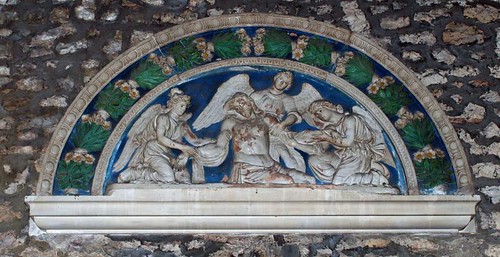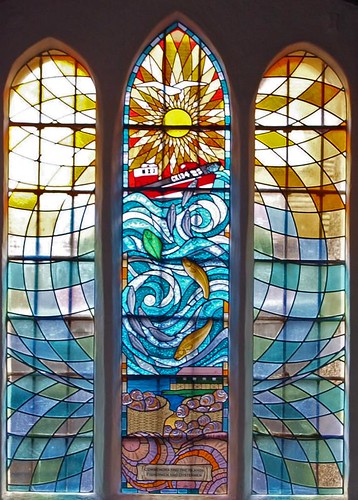The rendering has been removed from the south aisle, revealing a piece of Saxon carving, which gives a somewhat odd affect and there's quite a bit of unnecessary poor quality C20 painting.
Having said that it was open which is always a plus.
ST PETER AND ST PAUL. The church lies in the small original village area of what is now an extensive, but not yet badly spoiled seaside resort. The W tower in its lower parts is Early Norman. One N and one S window belong to that style. There were then no buttresses. Later, probably in the C14, buttresses were added, and the upper parts of the tower with handsome two-light transomed bell-openings and battlements. The rest of the church is also late medieval. Brick N porch, brick chancel, and brick E window of the S aisle. The nave was heightened in brick in 1833. Inside the church the severely plain tower arch clearly belongs to the Early Norman period, the S arcade of four bays with its octagonal piers and triple-chamfered arches to the C14. - FONT. Of the Purbeck type, C13, octagonal, with two of the usual shallow blank pointed arches to each side. - PAINTING. Pretty cartouches with biblical inscriptions on the upper nave walls. The date is no doubt. that of the heightening of the nave. - SCULPTURE. Lunette by Giovanni Della Robbia (?) Christ and three Angels. Clearly no earlier than the mid C16. - ROYAL ARMS. C18, carved, on the W wall.
WEST
MERSEA. There are Roman tiles in its Saxon tower and Roman fragments
appear wherever men dig about the churchyard. We must believe that this
mouth of the Blackwater river was a Roman centre of importance. Here a
mosaic pavement about 20 feet square and gay with roses and ivy leaves
was laid bare 200 years ago, and smaller pavements have since been
found. A little way from the church men digging a sawpit exposed a mass
of concrete resembling a six-spoked wheel 200 feet round, with 12 little
buttresses spaced on the rim. The nature of the round building these
foundations supported is a mystery; some antiquaries think it would be a
monument like those on the Appian Way, others that here stood a
lighthouse or a watchtower.
It was richer booty that fell to the excavators on opening a barrow on a farm a mile along the road to Colchester. Just below the level of the farmyard they found a small tiled chamber in which was a lead casket, 13 inches square and deep, containing a bowl of pale green glass. In this bowl were the ashes of a Roman who had been cremated in the first century.
From ruins of those days the Saxon builders of the tower picked up the masonry for the corners of a massive tower over 12 feet square. In its walls are their round openings with narrow splays, while the arch opening into the nave is shaped by Roman tiles and is nearly four feet thick. Made new in the 14th century, the Saxon church has two red consecration crosses still on the wall, and there is a marble font brought here by the Normans, resting on a round marble pier which some believe to have been found among the Roman ruins. Under the tower are two worn chests. Bright and shining is a 16th century lunette fixed in an aisle; it is a piece of Della Robbia ware in green and blue and white, with a reverent sculpture of Christ after Calvary, angels supporting him.
Flickr.
It was richer booty that fell to the excavators on opening a barrow on a farm a mile along the road to Colchester. Just below the level of the farmyard they found a small tiled chamber in which was a lead casket, 13 inches square and deep, containing a bowl of pale green glass. In this bowl were the ashes of a Roman who had been cremated in the first century.
From ruins of those days the Saxon builders of the tower picked up the masonry for the corners of a massive tower over 12 feet square. In its walls are their round openings with narrow splays, while the arch opening into the nave is shaped by Roman tiles and is nearly four feet thick. Made new in the 14th century, the Saxon church has two red consecration crosses still on the wall, and there is a marble font brought here by the Normans, resting on a round marble pier which some believe to have been found among the Roman ruins. Under the tower are two worn chests. Bright and shining is a 16th century lunette fixed in an aisle; it is a piece of Della Robbia ware in green and blue and white, with a reverent sculpture of Christ after Calvary, angels supporting him.
Flickr.



No comments:
Post a Comment